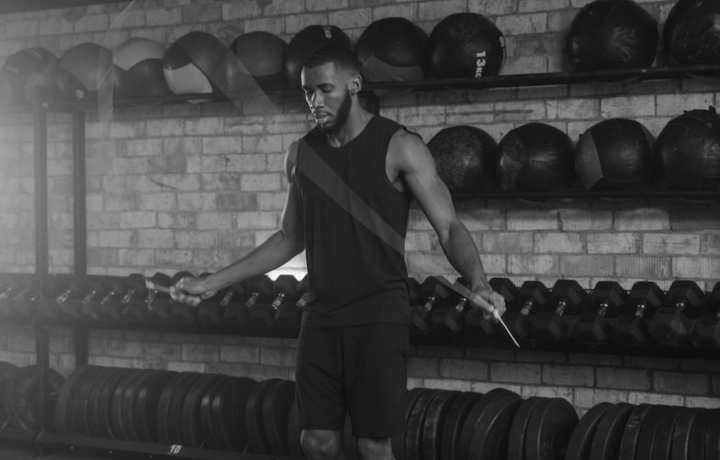Exercise
Single Leg Squat (Pistol)

Single Leg Squat (Pistol)
How to Perform
- Stand tall with your feet together, arms extended in front at shoulder level for counterbalance, and shift your weight to your right foot.
- Lift your left leg straight out in front of you, keeping your foot flexed and leg as straight as possible while maintaining a neutral spine.
- Inhale as you begin to bend your right knee, pushing your hips back as if sitting in a chair while keeping your chest up and extended leg parallel to the floor.
- Maintain tension in your supporting leg's quadriceps and glutes as you continue lowering your body, keeping your weight centered over the middle of your supporting foot.
- Descend until your hamstring touches your calf or as low as possible while maintaining balance, ensuring your supporting knee tracks in line with your toes.
- Pause briefly at the bottom position, keeping your core engaged and back straight to prevent rounding of the spine.
- Exhale forcefully as you push through your heel to extend your knee and hip, driving back up to the starting position without letting your extended leg touch the ground.
- Complete all repetitions on one leg before switching to the other side, maintaining proper breathing and tension throughout the movement.
Important information
- If you're unable to perform the full range of motion, use a bench or box behind you as a depth gauge, gradually decreasing its height as you progress.
- Keep your supporting foot flat on the ground throughout the entire movement—rising onto your toes indicates inadequate ankle mobility or strength.
- Maintain a forward gaze and upright torso to prevent excessive forward lean which can strain your lower back.
- Practice near a wall or sturdy object for support if balance is challenging, gradually reducing assistance as your stability improves.

Single Leg Squat (Pistol)
Exercise Details
Primary Muscles
Muscle Groups
Mechanic
Risk Areas
Built for progress
Take the guesswork out of training
Create personalized AI-powered workout plans that evolve with you. Train smarter, track every rep and keep moving forward, one workout at a time.






The pistol squat stands as one of the most challenging bodyweight exercises in the fitness world. This single-leg movement requires exceptional balance, mobility, and strength—pushing your lower body capabilities to their limits. As you descend on one leg with the other extended forward, you'll quickly discover why this exercise has earned respect among athletes and fitness enthusiasts alike.
Make no mistake—the pistol squat belongs firmly in the advanced category. This exercise demands a foundation of conventional squat strength, ankle mobility, hip flexibility, and core stability. Most fitness professionals recommend mastering basic squat variations before attempting this movement. Even experienced lifters often find pistols humbling, as they expose asymmetries and weaknesses that might go unnoticed in bilateral movements.
While pistol squats create a full-body tension demand, they primarily target the quadriceps and gluteal muscles. The quads handle the majority of the load during the descent and initial push of the ascent, while your glutes provide the powerful hip extension needed to stand tall. What makes pistols particularly effective is the intense isolation of each leg, preventing your dominant side from compensating for weaknesses.
In HIIT contexts, pistol squats serve as an intense metabolic stimulus that can quickly elevate heart rate while building strength. For bodybuilding purposes, they offer a unique stimulus for muscle development without external loads. The time under tension and range of motion create significant mechanical tension in the target muscles, stimulating growth even without weights.
Beyond aesthetic benefits, pistol squats build remarkable functional strength that transfers to athletic performance. The unilateral nature improves balance, corrects strength imbalances between legs, and develops proprioception. This translates to better performance in sports requiring single-leg power like running, jumping, and cutting movements. The stability demands also strengthen the smaller stabilizing muscles often neglected in traditional strength training.
FAQ - Single Leg Squat (Pistol)
Pistol squats demand exceptional unilateral strength, balance, and mobility all at once. By supporting your entire body weight on one leg through a full range of motion, you eliminate the compensation patterns that bilateral squats allow, forcing each leg to develop strength and stability independently.
Start with assisted variations like holding a TRX strap, squatting to a bench, or using a counterweight held in front of you. Focus on building single-leg strength through shallower ranges before attempting the full movement, and work on ankle mobility and hamstring flexibility separately to address common limitations.
For most trainees, 1-2 sessions per week is sufficient to develop the skill while allowing adequate recovery. Start with 2-3 sets of 3-5 reps per leg, focusing on quality over quantity, and ensure at least 48 hours between sessions targeting the same movement pattern.
The most frequent errors include rounding the lower back at the bottom position, allowing the knee to collapse inward, lifting the heel off the ground, or rushing through the movement. Focus on maintaining a neutral spine, tracking your knee over your middle toe, and keeping your weight centered through your entire foot.
While pistol squats deliver intense unilateral development, they shouldn't completely replace traditional weighted squats in a comprehensive program. Use pistols to address asymmetries, improve balance, and as a metabolic stimulus, but incorporate loaded bilateral training for maximum strength and mass development.







